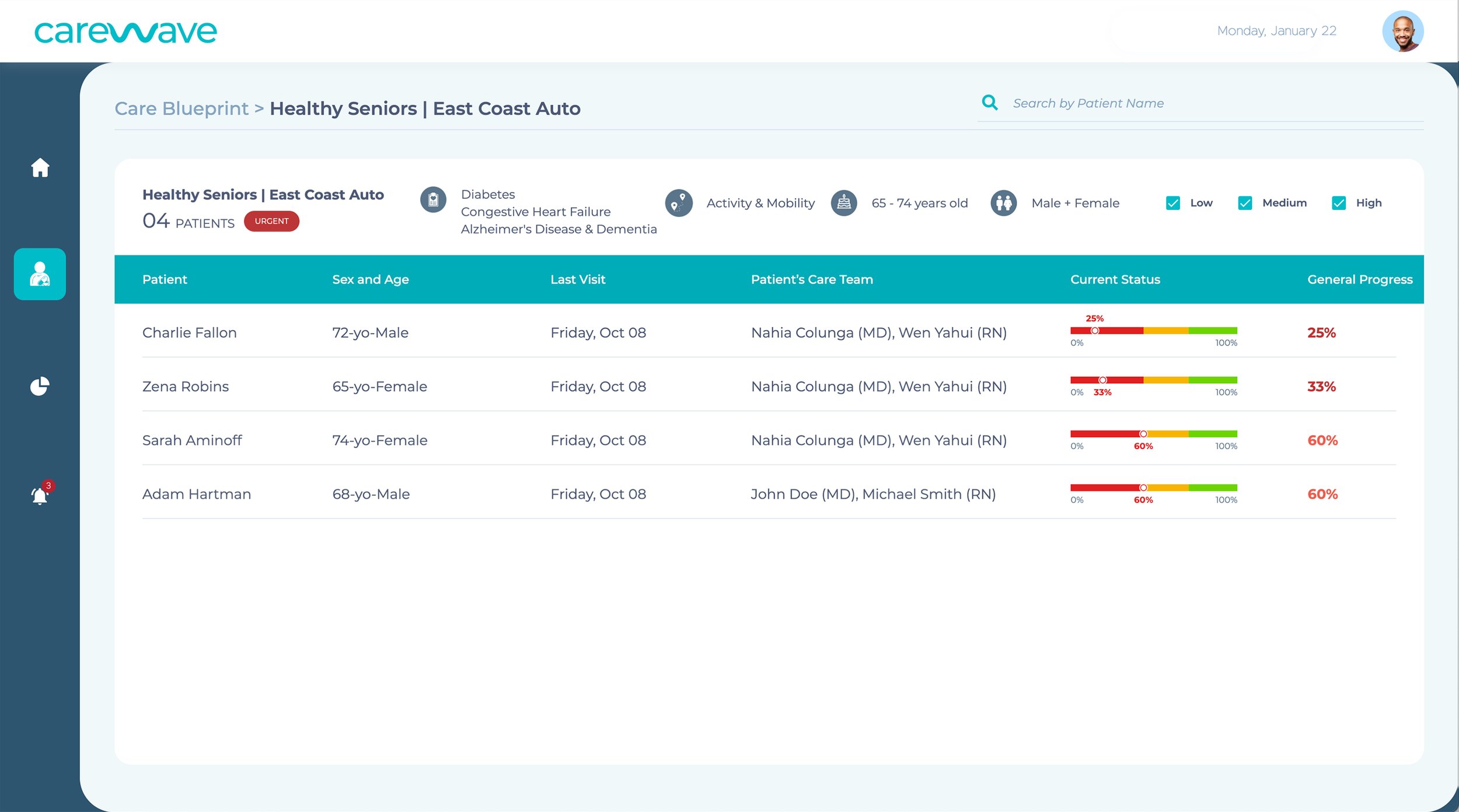Digital Health Management Platform MVP
Closing Care Gaps through Care Coordination & Analytics
Designing a Platform to Empower Care Teams and Close Gaps in Patient Care
In a fast-paced, three-month engagement, I helped lead the creation of an MVP interactive prototype for a digital health management platform. Working alongside stakeholders from across the healthcare and technology landscape, our goal was to transform complex, multidimensional health data into a simple, actionable experience for members, case managers, providers, and population health managers — and to do it in a way that would fuel early sales and adoption.
Overview & Context
I led the design of a digital health management platform MVP — an interactive prototype created to showcase a new care coordination and analytics solution for healthcare organizations. Built over a fast-paced three-month sprint, the prototype followed a scripted sales flow to demonstrate key capabilities across two types of users: case managers (care team), and population health managers (administrators).
The goal was clear: make complex healthcare data, including FHIR eCarePlans and Social Determinants of Health (SDOH) metrics, accessible and actionable.
The project team included the UX and Design Managing Director at Optimity, another designer, a project manager, and myself as Lead Designer. Our client stakeholders included the Product Manager, CTO, and SVP of Digital Health Platform Product.
The MVP played a critical role in aligning teams, enabling sales efforts, and expanded the client engagement by nearly 4x. The expanded scope included not only the prototype but also supporting collateral and sales decks that clearly communicated the platform’s value proposition.
My Role
UX/UI Design Lead
Research & Rapid Discovery
Prototyping (High-fidelity / Interactive)
Stakeholder Management
Design Strategy and Storytelling
The Challenge
How might we translate multidimensional healthcare data into intuitive, actionable tools for different user types — under aggressive timelines?
Make FHIR CarePlans and SDOH factors user-friendly.
Tailor flows for case managers and population health managers.
Script the experience tightly to support proof-of-concept sales demos.
Deliver daily iterations to keep stakeholders closely engaged.
Discovery
Stakeholder interviews to understand clinical workflows and expectations.
Rapid secondary research on SDOH, FHIR eCarePlans, and population health trends.
Developed key personas: Sara (Population Health Manager) and Paul (Case Manager).
User journey mapping to pinpoint gaps and design interventions.
Key Insight: Users needed real-time visibility into patient risks and straightforward action paths — without having to parse complex clinical data manually.
Visualizing how interventions can be triggered through smart alerts and insights at key patient touchpoints.
Definition
Defined two primary experience modules:
Care Coordination for case managers.
Population Analytics for population health managers.
Introduced Health Foundations Framework to group multidimensional data into actionable domains.
Outlined scripted demo scenarios and user flows to keep the MVP focused and persuasive.
Clear cohort views showcasing patient group status and care priorities.
Ideation
Wireframed multiple layouts for dashboards, cohort navigation, patient profiles, and analytics.
Balanced information depth with usability, ensuring clarity at every step.
Validated flows through low-fidelity prototypes with stakeholders.
At-a-glance health trend indicators designed to trigger quick action from managers.
Prototyping
Built a high-fidelity interactive prototype using Axure RP.
Simulated "smart behavior" using conditional logic and scripted flows.
Daily standups ensured tight feedback loops and rapid iteration.
A complete patient snapshot blending care goals, trends, and immediate recommended actions.
Visualizing patient engagement and well-being progression over time.
Validation
Conducted stakeholder dry-runs to test usability, navigation clarity, and narrative flow.
Incorporated feedback iteratively, ensuring the experience supported compelling sales conversations.
Simplified complex analytics into visual narratives highlighting real-world impact.
Linking interventions directly to measurable improvements in health outcomes and costs.
Outcomes
Expanded Scope: Engagement grew by almost 4x, securing further development.
Sales Enablement: Prototype served as a powerful demo tool, helping win early pilot programs.
Internal Alignment: Provided a tangible product vision that bridged business, clinical, and engineering teams.
Design Wins: Delivered intuitive workflows that made complex clinical data actionable and digestible.
Reflection & Lessons Learned
This project reinforced the importance of storytelling through design. A scripted, realistic flow made the platform's value tangible and persuasive in ways static presentations couldn't.
It also proved that continuous collaboration with stakeholders — treating them as active design partners — accelerates clarity, consensus, and quality.
Finally, it reaffirmed that great UX unlocks business outcomes. By investing early in user-centered design, we created not just a better prototype but a better future product roadmap.







